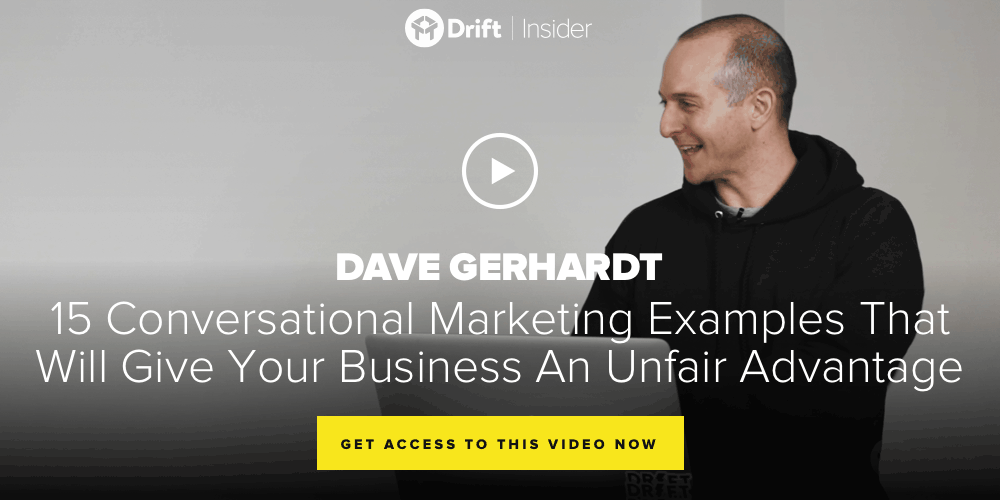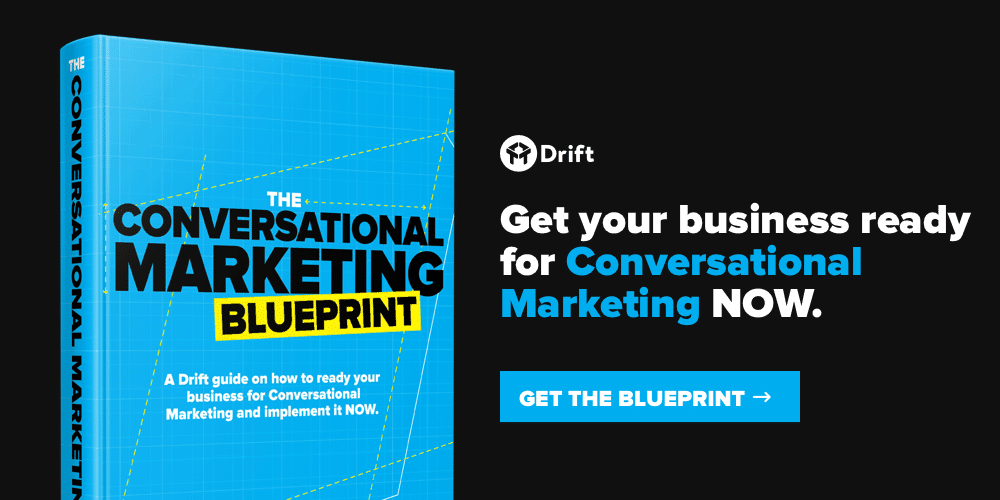
Conversational marketing isn’t about you. It’s about your buyers. It’s a new way of thinking because it’s focused on the buyer’s goals not your company’s goals.
It’s the fastest way to move buyers through your marketing and sales funnels through the power of real-time conversations
But in the last couple decades, the buying process has grown unnecessarily complicated. Instead of having more conversations, we’ve created more distance between businesses and buyers. Blame it on automation, aggressive sales tactics, or spray-and-pray emails—the end result is the same: the B2B buying process is broken.
By sticking to the old marketing and sales playbook, we’ve been forcing potential customers into a buying experience that serves us and not our buyers. This endless process looks something like this:
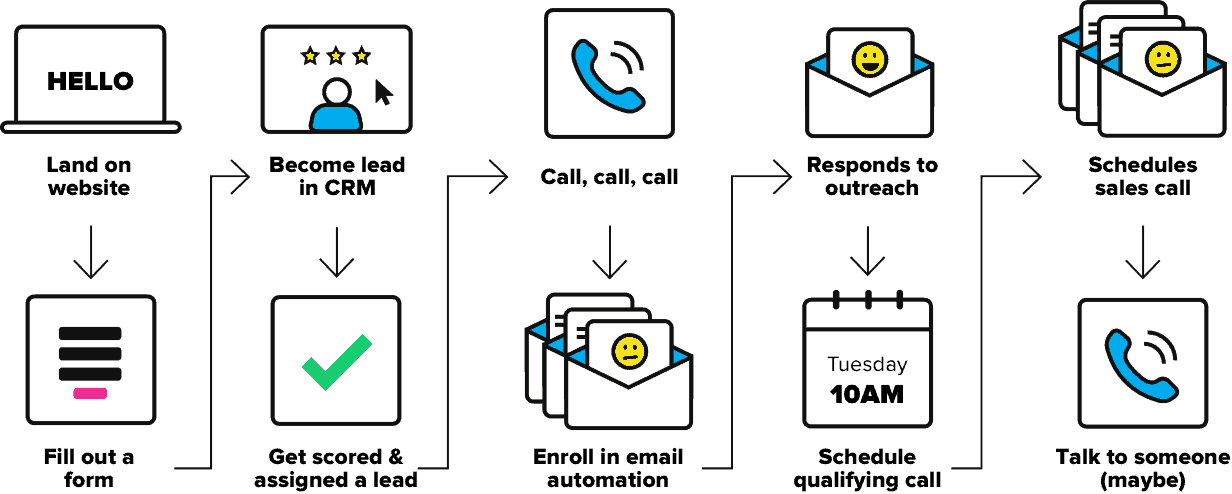
That is, until now.
With the rise of conversational marketing platforms like Drift, we have the opportunity to make business actually feel personal again.
So, What Exactly Is “Conversational Marketing”?
Conversational marketing is the fastest way to move buyers through your marketing and sales funnels through the power of real-time conversations. It builds relationships and creates authentic experiences with customers and buyers.
Why does it work? Well, think of the best buying experiences you’ve ever had.
What comes to mind? If you’re like a lot of people, it’s probably when you were able to have an easy conversation before buying something, like at an Apple store.
Conversations like these create the opportunity for a warm, human buying experience. And when done right, they also have the potential to help close deals faster than anything else.
Buyers have all of the power today because real-time interactions have become the default. Conversational marketing is how you have conversations now and build relationships in today’s world. It’s not a new marketing and sales funnel. It’s a new way to move people through your funnel.
Implementing conversational marketing doesn’t force you to blow everything up and start from scratch. It’s the fastest way to move buyers through your marketing and sales funnel.
It’s more like turning on a new lead-gen channel that complements your existing marketing efforts. We boiled it down into a simple framework called the Conversational Framework: “Engage, Understand, Recommend.”
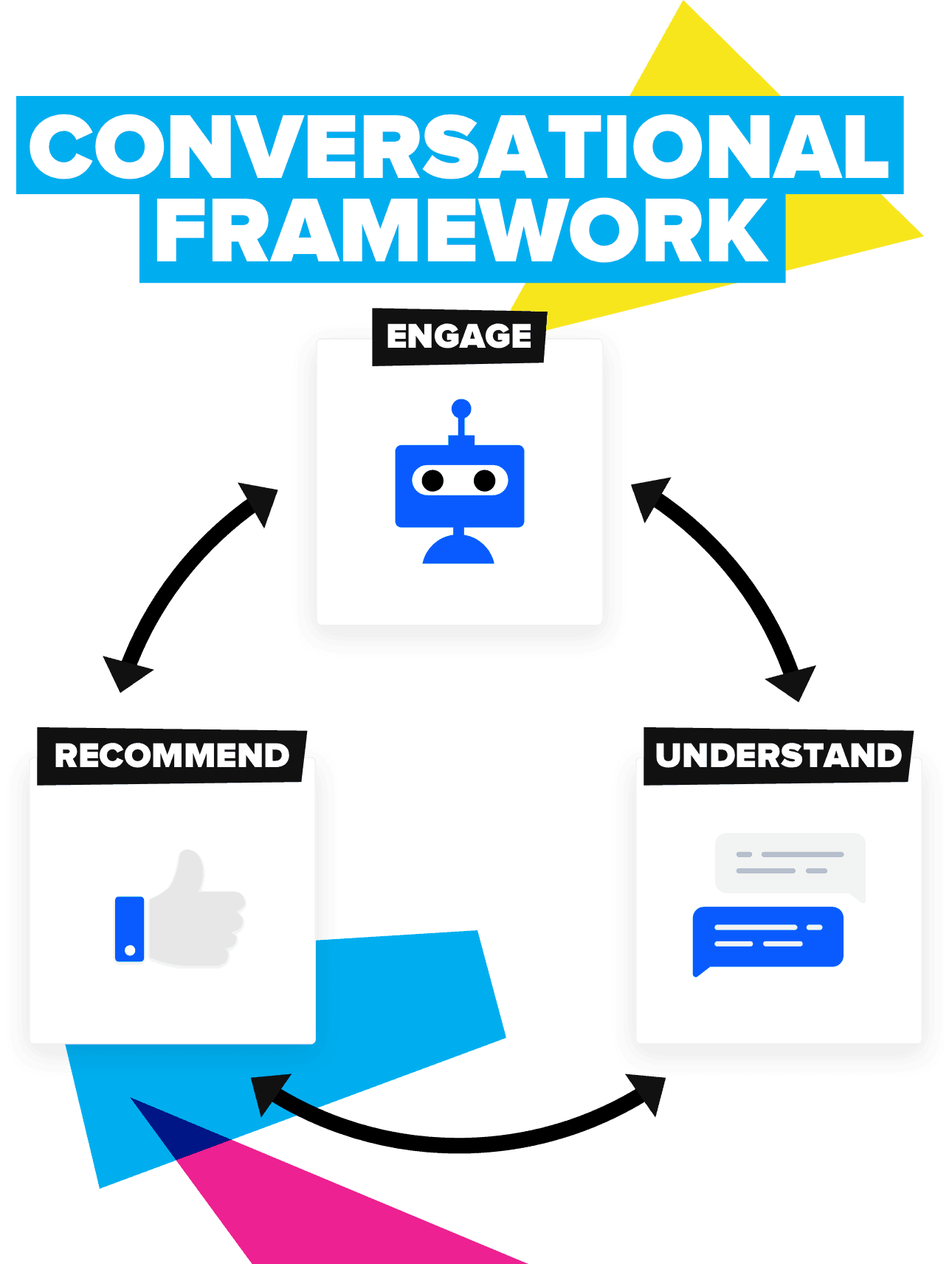
Conversations are the fundamental way humans engage, understand, and recommend things to one another.
It’s Easier to Scale Than You Think
But there’s always been that question around scaling conversational marketing. With so many visitors to your website, how is it possible to engage in real-time conversations with all of them? And how would you be able to qualify them quickly?
For far too many marketers, the answer was forms that looked something like this:
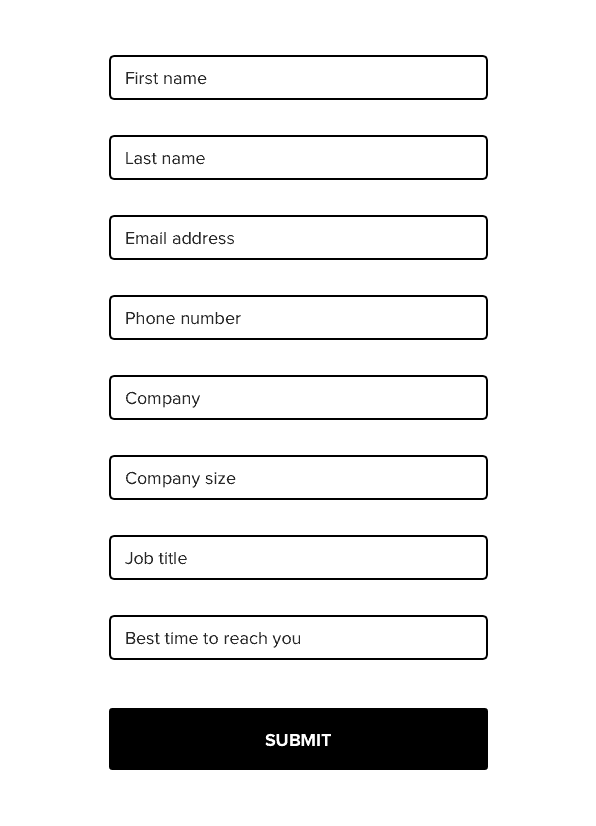
In a lot of cases, visitors filled out these long lead-forms just to get in touch with someone. After that, they’d typically wait hours (or days) before either hearing from a sales rep, or getting dumped into a series of automated emails.
For a long time, this was considered the best-in-class lead generation and qualification practice for two main reasons:
- Email was basically the only option customers had for communicating with businesses online
- Forms and nurturing sequences provided the fastest way for marketing and sales teams to qualify leads at scale
But in a world where the first tools we turn to for communicating are powered by real-time messaging—whether that’s Slack, SMS, or social media—the typical lead form response time feels like a relic of the past.
Wait for days to get a reply after expressing interest in a product? No modern buyer shops like that. Messaging has conditioned us to expect real-time responses, which lead forms and nurturing sequences almost never offer.
When Drift filled out lead forms from 433 leading B2B SaaS companies, it took 55% of them 5+ days to respond—a ridiculously long time to wait when you just have a question about a product. These kinds of delays in response time have a massive impact on whether you ultimately close that business. In fact, according to Harvard Business Review, there’s a 10x decrease in your odds of making contact with a lead after the first five minutes.
By implementing conversational marketing tools, businesses can fix the lead response time challenge. New messaging solutions give marketing and sales teams a way to have real-time, scalable conversations with customers in a format customers actually want to use.
Marketing At the Speed of Conversation
According to a recent study from Twilio, 90% of consumers want to use messaging to communicate with businesses (and the majority prefer it over email).
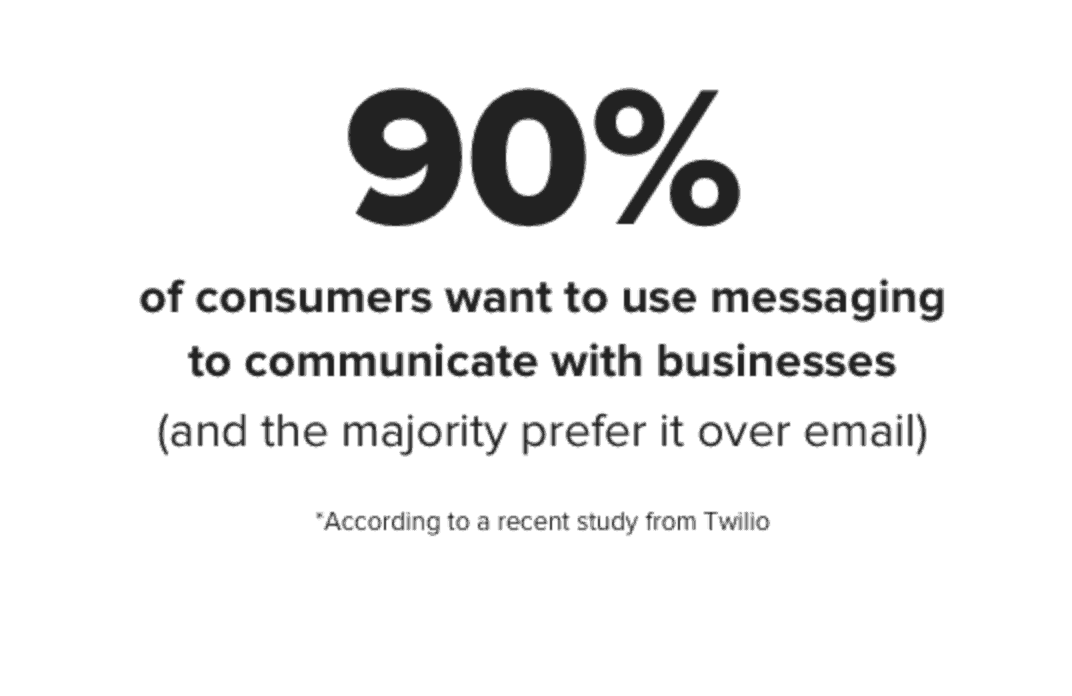
Conversational marketing uses real-time messaging and intelligent chatbots instead of lead-capture forms, so leads never have to wait for follow-ups. This allows leads to engage with your business instantly whenever it’s convenient for them, like when they’re on your website.
This gets you closer to customers, and removes a ton of friction from the buying process.
Practice Makes Perfect
OK, so it all makes sense in theory, but what about the actual practice of conversational marketing?
Conversational marketing and sales is changing how businesses buy from other businesses. Why? Because buyer behaviors and expectations have changed and it’s about time we as marketers and salespeople caught up.
Since we’ve seen thousands of businesses transformed through the power of conversational marketing, we decided it was time to write that playbook.
At this point you might be wondering, “Great, but where do I start?”
We’ve turned to the data from over 50,000+ businesses using Drift and put together a series of plays you can use to get started with conversational marketing.
Ready? Let’s go!
The 10 Plays You Can Use to Become a Conversational Marketing Pro
1. Second Net Bot
The Situation:
- You have a page that has a form on it to try and drive conversions.
- And you’re not willing to rip out that form because it does drive some conversions, and you want an easy way to implement conversational marketing without changing up your entire workflow.
- But the conversions on that page aren’t amazing. They sit around 1-2%
- So we prescribe: The Second Net bot
The Play:
- Show on pages that have forms
- Proactively hook visitors by allowing them to skip the form and get to their end goal faster with the bot
- Let the buyer skip the unnecessary questions, skip the line, and connect with your team now.
While we think the benefits of no forms are clear, we also know that ripping all of the forms off your website isn’t always feasible in the short-term.
That’s why a ton of companies get started with conversational marketing by using it as a “second net” that gives visitors a faster alternative to filling out a form. Perfecto Mobile did this on their “Contact Us” page, and according to CMO, Chris Willis, the approach increased their conversion rate from 6% to 10% and allowed them to qualify and close leads much faster.
“Leads that come in through chat tend to have a higher velocity…If they’re able to skip the form and have a conversation in real-time, we’re seeing that move very quickly.”
– Chris Willis, CMO, Perfecto Mobile
Look, you don’t have to blow up your entire marketing strategy to start experimenting with conversational marketing. Using real-time messaging as a second net will give you the ability to quickly compare performance of your forms with chat.
Real-time messaging doesn’t just start conversations—it also captures leads for you. And unlike the old-school forms you may have used to do the same thing, chats feel human and way more personal. This often leads to a better buying experience, and higher visitor-to-lead conversion rates.
For example, rather than forcing visitors to fill out a lead form to book a demo at Drift, we use our chatbot to get meetings on the books.
Since replacing lead forms with messaging nearly three years ago, we’ve seen:
- More leads—net new leads have increased by over 15%
- More pipeline—50% of business is now driven by conversations
- A faster sales cycle—it only takes 3 days on average to go from first conversation to demo
But we’re not alone.
When RapidMiner replaced their gated content and lead forms with messaging, they were able to capture over 4,000 leads within just a few months, while also influencing over $1 million of pipeline.
When SalesRabbit tested their “Request a Demo” form against a chatbot that helps visitors request a demo, they found that 42% of people who booked a meeting through the bot actually completed the demo, while only 25% of people who used the form ended up completing one.
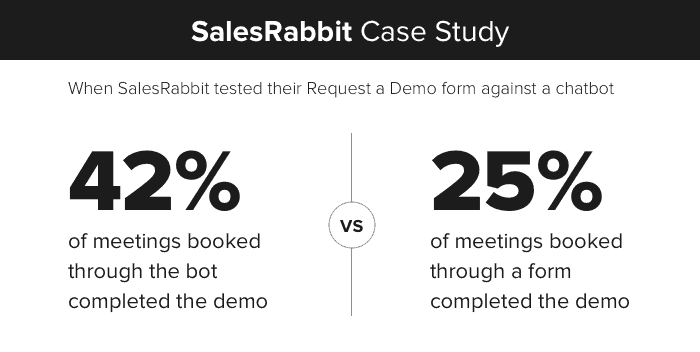
Substituting conversations for forms doesn’t mean you’re giving up capturing leads. Any email address a prospect gives you over chat automatically gets stored as soon as they enter it.
⚡️ Get the Blueprint
? See an Example
2. Conversation Starter Bot
The Situation:
- You don’t have a ton of traffic that comes to your site
- And you want to take advantage of the traffic that you do have by driving qualified conversations all over your site
- But you don’t want to have a “one size fits all” website experience
- So we prescribe: The Conversation Starter.
The Play:
- Show on your highest trafficked pages (home, products, pricing, etc.), but target to find engaged visitors
- Great copy, headline, hook, and offer will get you more conversations
- Think: what would you say in-person? Or what would stop someone in their tracks to talk to you
- PRO TIP: The preview text is 100 characters
⚡️ Get the Blueprint
? See Examples
3. Pricing Page Bot
The Situation:
- You have a pricing page. A page that shows a higher intent from your buyers than most pages on your site
- OR you gate your pricing with a form but see more support questions than actual sales conversations going into that form.
- But you want to be able to answer questions on how your pricing actually works, which plan would be best for them, without updating the website.
- So we prescribe: The Pricing Page concierge
The Play:
- This is one of the highest intent pages on your site, but gets a lot of questions
- Answer overarching questions about pricing, to get more details it’s best to chat with a member of your team
- Let the buyer get just enough information where they want to connect with your team to discuss their use case.
You can also uncover visitors’ buying intent by greeting them with an automated message that asks questions based on what visitors are most likely to be curious about. MongoDB uses this strategy on all of their product pages.
By being direct and asking visitors if they have a question about pricing or sales, MongoDB has cut down on conversations that aren’t likely to lead to a purchase. That’s allowed Director of Demand Generation, Andrew Racine, to stop worrying about handing his sales team leads that aren’t qualified.
“By asking visitors if they had pricing or sales questions we were able to weed out a lot of noise/junk and get our LDR (lead development rep) team the types of conversations they needed.”
– Andrew Racine, Former Director of Demand Generation, MongoDB
If you want to make sure you’re surfacing the conversations that are most likely to produce sales, asking qualifying questions on high-intent pages is a great place to start.
⚡️ Get the Blueprint
? See Examples
4. Retargeting Bot
The Situation:
- You have a lot of traffic coming to your site either through retargeting campaigns, your content, or a loyal following of fans.
- And you know that returning visitors have higher intent and a higher chance of converting
- But you treat those visitors just like first time visitors. You don’t create a custom experience for them on your website
- So we prescribe: The Retargeting Bot
The Play:
- Create a custom experience for returning traffic on your site
- Driving that returning traffic lower down your funnel to create more qualified conversions with already engaged visitors.
Of course, if you’re taking an account-based approach to marketing, you’re probably actively reaching out to prospects with outbound email. Now, you can connect those emails to this kind of conversational experience on your website by triggering personalized messages when your prospect clicks any link you send them.
Instead of forcing them to go to your website, decide if they want to respond, return to their email client, and wait hours to get a response back, they can simply start a real-time conversation right there on the website.
⚡️ Get the Blueprint
? See an Example
5. Account Based Marketing Bot
The Situation:
- Your sales team has a list of 100-1000 dream customers that they’re trying to target
- And you’ve been aiding in that outreach with campaigns like direct mail, ads, etc.
- But when that account comes onto the website, they don’t get the red carpet rolled out for them, they have to jump through the same hoops as everyone else. PLUS the rep doesn’t know that the account is on the site and has to follow up with them later.
- So we prescribe: The Dream Client Finder aka ABM
The Play:
- Create a custom experience for returning traffic on your site
- Driving that returning traffic lower down your funnel to create more qualified conversations with already engaged visitor.
The ABM Bot focuses on lead quality versus lead quantity.
Today, 70% of all B2B companies are already doing some form of account-based marketing (ABM).

It might sound complicated, but the definition is pretty straightforward—it’s when your organization treats a particular prospect or account like a market of one.
Rather than marketing to an industry or companies that meet certain firmographic criteria (like in the previous examples), ABM targets individual companies with personalized content and campaigns.
But historically there’s been one big problem with ABM—when the people from the account you’re trying to sell to come to your website, they have to jump through the same hoops as every other website visitor in order to talk to you.
That’s where account-based targeting with conversational marketing comes in.
With this approach, your accounts will be greeted by a personalized message from their account owner when they visit your website:
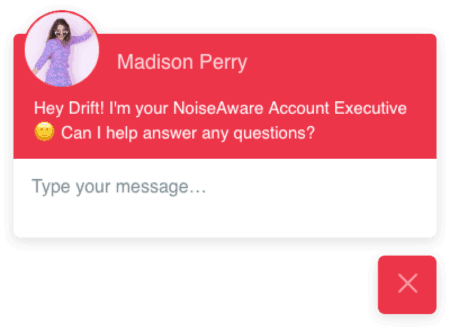
Meanwhile, the account owner will receive an instant notification that someone they’re dying to talk to is live on the website.
Now let’s touch on firmographic targeting.
Firmographic targeting can be used to serve messages to leads based on characteristics of the organization they work for.
Using Drift’s integration with Clearbit, Perfecto Mobile was able to identify company size based on any anonymous visitor’s IP address. If the company was large enough, that meant they were qualified.
“We’re able to, by IP address, identify companies by their size, and only present to our SDRs chats that come from companies that we want to sell to,” said Perfecto Mobile CMO, Chris Willis.
Segment, the customer data platform, wanted to take a similar approach to conversational marketing, since they’d already figured out that only around 10% of the people visiting their website were an ideal fit to talk to sales.
16% of their signups represented 86% of their revenue—and those were the kinds of people they wanted to reach out to in real-time.
Like Perfecto Mobile, Segment started using the Drift and Clearbit integration to identify leads based on their company. But then they took their targeting a step further by running the prospective company through their own lead-scoring model. If it identified the company as a good fit, the visitor would receive a custom message that even mentioned their company by name. For example, here’s what it looks like when a Drift employee visits Segment:
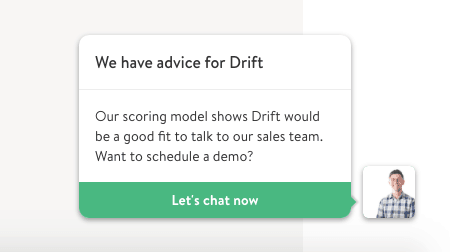
Impossible to ignore, right?
Segment’s leads thought so, too. After implementing this personalized campaign, they saw a 5x increase in engagement (people clicking on the chat CTA) and a 2x increase in conversations. Today, real-time messaging is their #1 source of qualified opportunities.
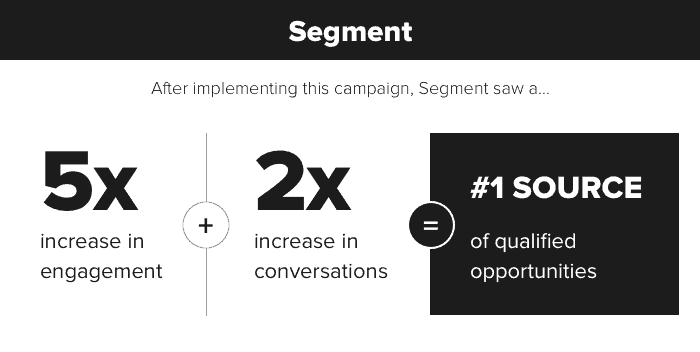
Even though this may seem like an advanced strategy, the nice part is that Segment didn’t have to dramatically alter their entire approach to sales and marketing. In fact, they didn’t even remove any lead forms from their site. They simply added a single targeted messaging campaign as a second net.
6. Paid Ad Converter Bot
The Situation:
- You spend a LOT of money on paid campaigns. But you drive that traffic to an overview page with a form on it, or treat that traffic just like anyone else.
- And you know that paying for traffic means that you need to convert more of those users to make your campaigns successful
- But you treat those visitors just like anyone else who comes on to your website
- So we prescribe: The Paid Ad Converter
The Play:
- Make sure you keep your traffic’s attention.
- You can get super granular and personalize the messages based on the campaign, keyword, or source the visitors are coming from. If you’re going to pay for traffic, make sure you’re giving those visitors a more custom experience than anyone else on your site
⚡️ Get the Blueprint
? See an Example
7. Lead Magnet Bot
The Situation:
- Your have a ton of “middle of the funnel” content
- And you drive a lot of traffic to that content
- But you have a hard time moving those leads further down the funnel to try and get them to buy or chat with your team.
- So we prescribe: The Lead Magnet bot
The Play:
- You marketing and content teams are pushing out a ton of resources for your middle of the funnel traffic but you’re having trouble driving traffic from the middle of the funnel to the bottom of the funnel
- You want a way to connect people who download content to your sales team when their intent is highest:
⚡️ Get the Blueprint
? See an Example
8. Demo Bot
The Situation:
- You have a “request a demo” form that you try and drive traffic to from your homepage and other pages on your site
- And you’ve been trying to optimize that page for conversions and have been using Drift to book meetings on other pages on your site.
- But the form doesn’t convert well.
- OR you’ve been using Drift as a second net on your demo form and it’s outperforming your demo request form.
- So we prescribe: The Demo bot
The Play:
- People who request a demo from your team have super high intent, but making them jump through hoops means your conversion rate is pretty low.
- This could end up being a replacement for your request a demo/contact us form can help you ask fewer questions, drive more conversions from your high intent visitors and book meetings for your sales team when their prospects are ready
⚡️ Get the Blueprint
? See an Example
9. Email List Supercharger Bot
The Situation:
- Your blog drives a ton of traffic to your site and you’re trying to build up your subscriber list
- This could end up being a replacement for your request a demo/contact us form can help you ask fewer questions, drive more conversions from your high intent visitors and book meetings for your sales team when their prospects are ready
The Play:
- Proactively reach out to the traffic you’re driving to your blog to add more subscribers
- This could end up being a replacement for your subscription form and help you personalize your subscription message based on the URL of the blog
⚡️ Get the Blueprint
? See an Example
10. Fastlane Bot
The Situation:
- You have an ideal customer fit profile you want to drive more conversations with on your website
- And you want to give them direct access to your team
- But they are currently treated like any other website visitor
- So create a Fastlane bot to immediately engaged those ICP buyers with sales.
The Play:
- Use targeting conditions to omit qualification questions. If you don’t have firmographic targeting, ask your most important qualification question first, and then give those leads a fastlane to sales.
- Make the bot as painless of an experience as possible, but if someone isn’t ready to schedule a meeting yet, offer a piece of content
⚡️ Get the Blueprint
? See an Example
How to Get Started with Conversational Marketing
Getting started with conversational marketing doesn’t have to be complicated.
A conversational marketing and sales platform like Drift integrates with all the tools you’re already using (Salesforce, Marketo, etc.), and you don’t have to dismantle your old lead forms and automation sequences to start seeing the benefits.
Like we mentioned earlier, you can leave your old system in place and simply add real-time messaging as a “second net,” and automatically source additional leads that are likely slipping through the cracks right now.
If you want to experiment and prove the value of this approach before trying to get adoption across your entire organization, it’s easy to start small. A single BDR can schedule meetings for dozens of reps.
But the simplest way to get started is to just ask yourself what kinds of conversations you want to have. What would be most beneficial to your current goals? Do you want to attempt to capture and qualify as much of your website traffic as possible, or do you want to target conversations at a small percentage of your highest quality leads?
Those questions will help you figure out where you want to drive conversations on your website and what types of targeting and filters to implement.
How to Measure the Impact of Conversational Marketing
You’ve already seen plenty of customer data that proves the impact conversational marketing can have on businesses, but let’s review them again quickly.
When you’re measuring the impact of your Conversational Marketing efforts, there are a few metrics you should pay attention to. But the most important thing to keep in mind is: “What metrics are YOU trying to move?” Is it emails captured? Is it meetings booked? Is it percent of traffic driven to a certain page?
When it comes to measuring attribution, don’t just consider net new accounts/contacts but the touches along the way: So, for instance, if you’re using Meetings Booked as a success metric, which should be the case for some of bots you run on your site, you should look at your Email Capture > Meeting booked metric. On our highest performing Bot at Drift – the “Request a Demo” Bot – we have a 22% email captured to meeting booked rate. With our lower intent Bots that run on our marketing site or our product pages, we strive for a 5% email capture > meeting booked rate. As always, when measuring conversion rates the answer is always “it depends”, however these are some baseline metrics your team can measure from your playbooks.
- You’ll create a more human buying experience. With bots handling all of the tedious tasks, your reps can give 100% of their focus to providing a human touch and helping people.
- You’ll grow your sales pipeline. Conversational marketing now drives 50% of our business at Drift.
- You’ll shorten your sales cycle. ThriveHive has shortened their sales cycle by 63%—from an average of 11 days down to only four.
- You’ll learn a ton about your customers. When you’re having conversations with prospects non-stop, you’re learning about your prospects non-stop.
- You’ll add a net new source of leads. At Drift, we’ve added over 15% new leads by having conversations. These are leads that simply couldn’t be bothered to go through lead forms in the past.
The great thing about getting started with conversational marketing is that you can see big benefits quickly without making drastic changes to your website or marketing strategy.
So, now that you’ve got the 10 plays needed to become a conversational marketing pro, you’re ready to get started. But don’t worry–we’re still here to help. If you have questions that come up along the way, just chat in to our team!




